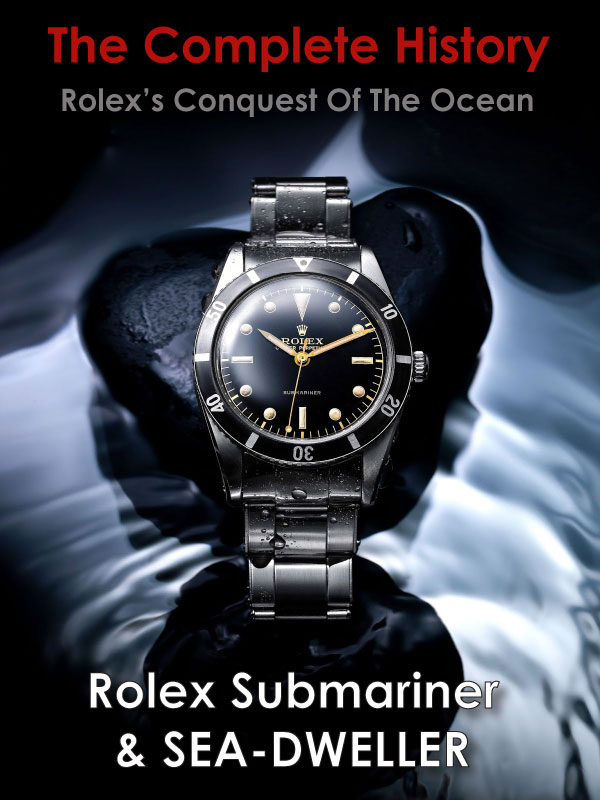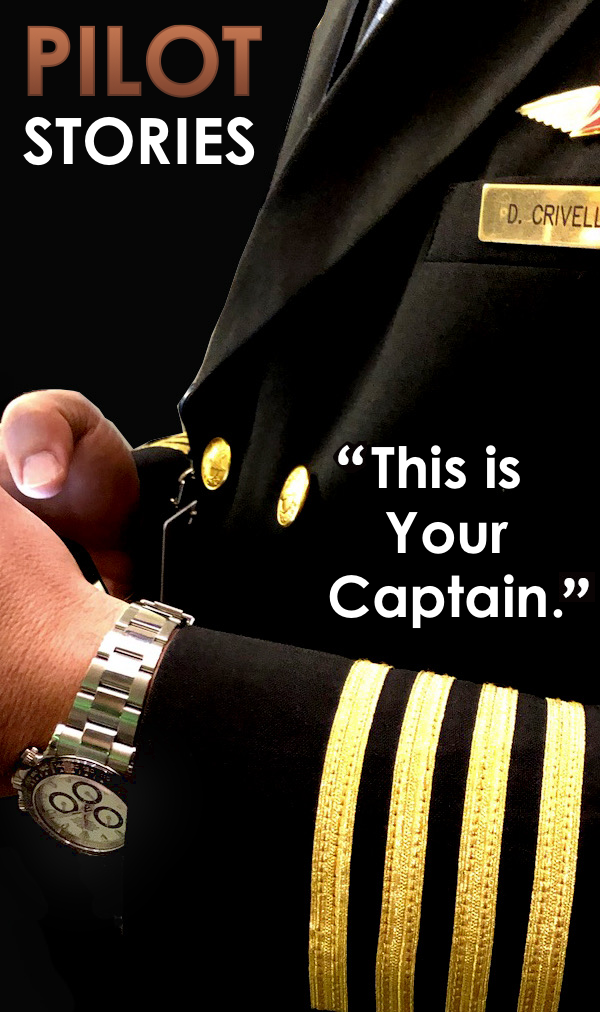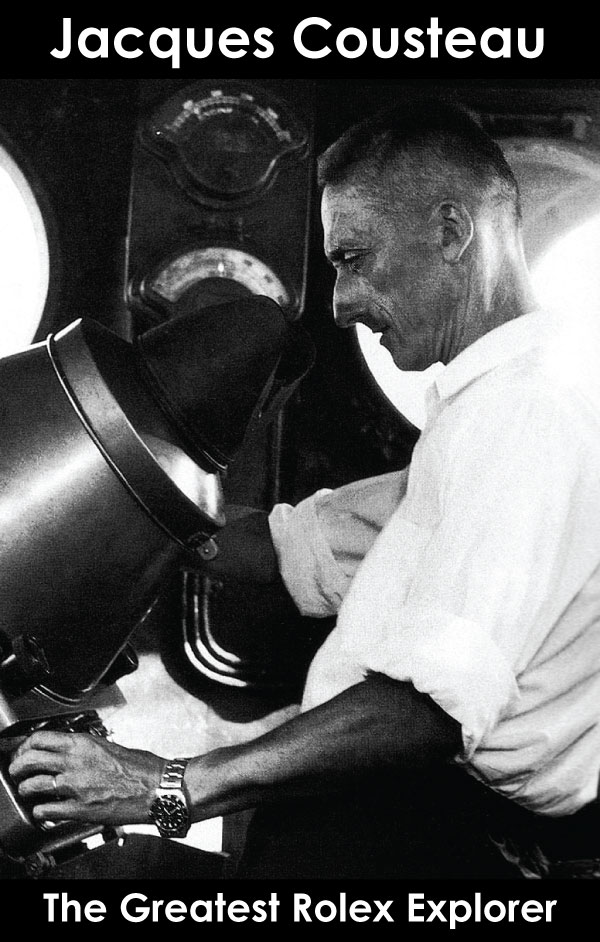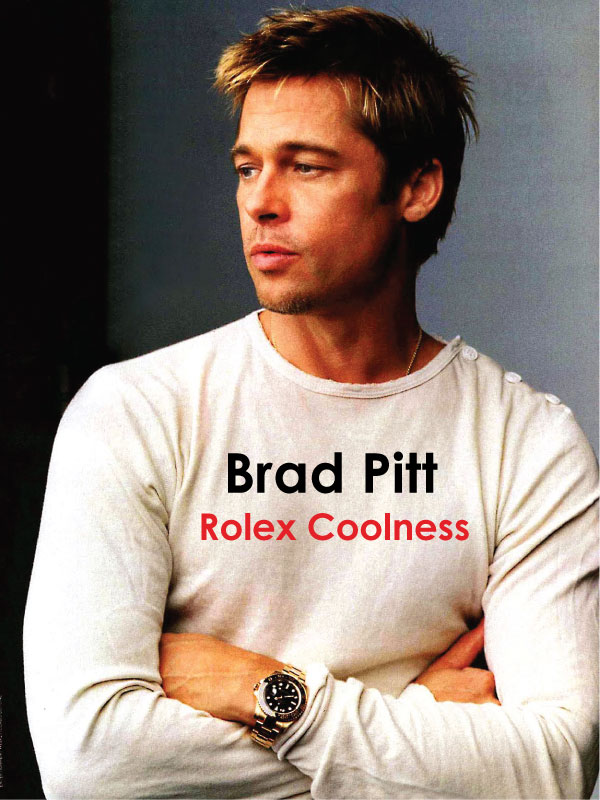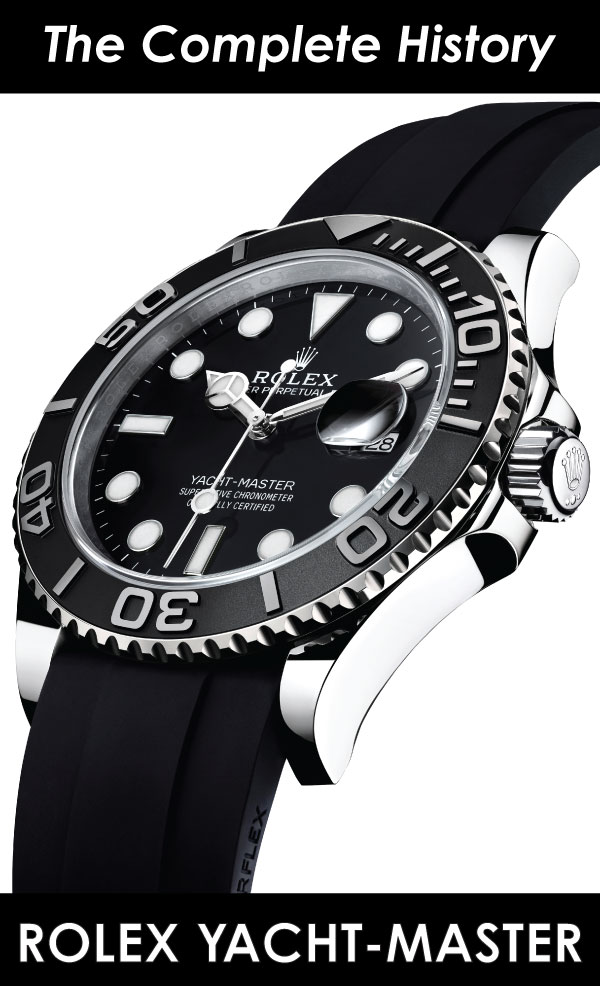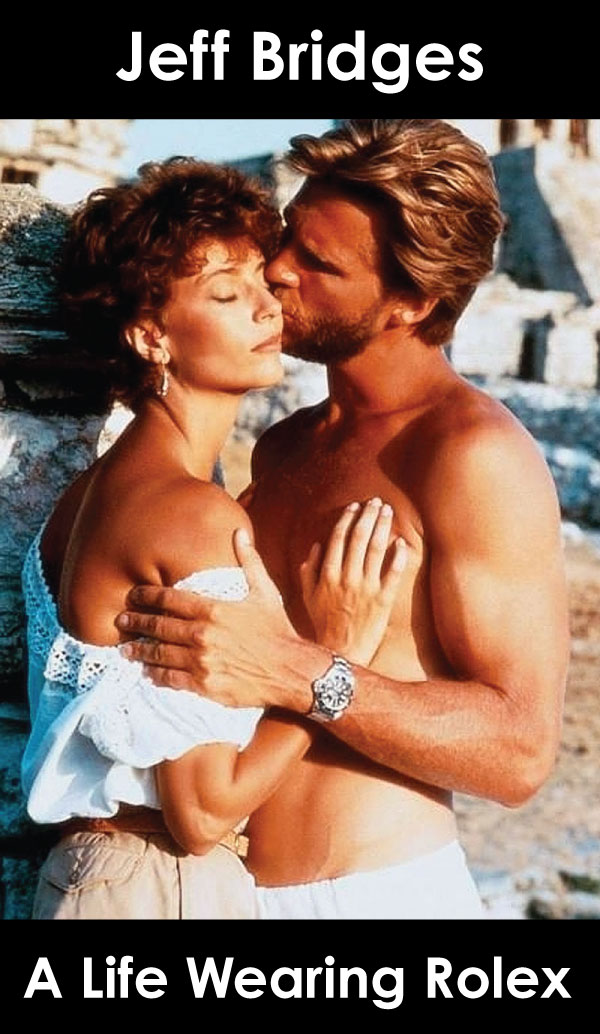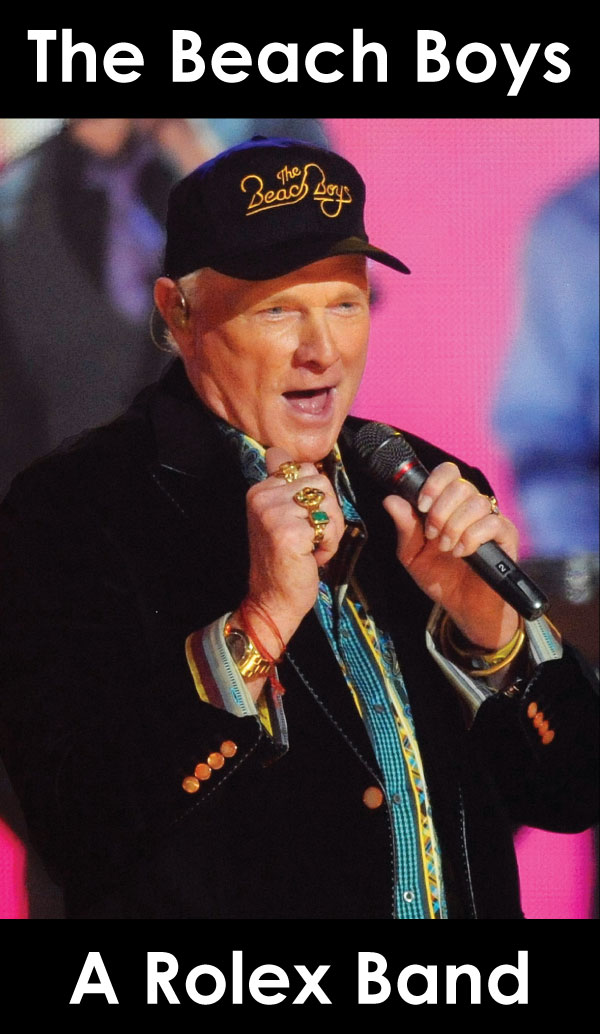The Complete History Of
The Rolex Submariner & SEA-DWELLER
Rolex's Conquest Of The Ocean
CHAPTER 19
Part 2 of 6
CHAPTER 19
Part 2 of 6
Diving Into
THE DEEP
If you are reading this, chances are you just learned about the exciting new 2017 Rolex Single RED SEA-DWELLER. The story below goes into great depth on the history of the SEA-DWELLER and explores its relationship to it smaller big brother—the Rolex Submariner. It also takes you, step-by-step, through the past few centuries of horological progress that lead up to the present...
Before you begin reading the story below—it is worth noting—it is by far and away the single largest, and most immersive Rolex history piece I have ever documented—by a long-shot. This is a really, really deep story that contains more than 300 images and videos, and goes into great detail on what is probably the most iconic, revered and copied watch on earth. This story is so big, I had to break it up into 6 Parts, and I added a simple navigation table of contents located at the bottom of each part.
My goal with this story is to take a highly complicated piece of significant Rolex history, that until now has been very confusing and convoluted, and make it highly educational, while being very simple to understand. I am attempting to clarify a subject that practically confused me to death, that I have been trying to figure out for the past 35 years!?!! I believe I have all the key puzzle pieces put together for the first time, and am quickly finishing up the puzzle.
This epic story is about Rolex's deepest diving watches which conquered the Ocean, and I would argue this story is equally DEEP...So let's plunge into The Mystic DEEP-SEA World of Rolex History...
Rolex
SEA-DWELLER
50th Anniversary
Jubilee Celebration
The Rolex SEA-DWELLER is the stuff of legend. The story of Man and the Sea, as well as the story of Man and Machine, have captivated and fascinated the human imagination and psyche since the beginning of recorded history. This story of the exploration of inner-space tells how the science fiction of one century became the reality of the next century, and how Rolex played a critical role in the history of The Right Stuff. It tells the story of man returning to live and work underwater in the DEEP-SEA, as depicted in 1871 illustration seen below from Jules Verne's 20,000 Leagues Under The SEA. It's Captain Nemo and the Nautilus come to life...This story is about astounding exploration, fueled by The Spirit Of Inquiry...So let's hop in The Rolex Time Machine and set out on a Fantastic Voyage...
French 20,000 Leagues Under The Sea Illustration from 1871 depicts two men located in bottom left corner Dwelling under the Sea
"The important thing is to not stop questioning. Curiosity has its own reason for existing. One cannot help but be in awe when he contemplates the mysteries of eternity, of life, of the marvelous structure of reality. It is enough if one tries merely to comprehend a little of this mystery every day. Never lose a holy curiosity!!!" —Albert Einstein
Rolex Etymology
Have you ever wondered where all the different Rolex models got their names from? This article, will explore, among other things, the etymology of where the Rolex Submariner, SEA-DWELLER and DEEP-SEA Special Prototype got their names and reveal exactly what they mean.
et·y·mol·o·gy
ˌedəˈmäləjē/
noun
- the study of the origin of words and the way in which their meanings have changed throughout history.• the origin of a word and the historical development of its meaning.• plural noun: etymologies
- synonyms:"the etymology of a word may be unknown"
What Is A Submariner?
Where did the Submariner designation nomenclature come from? This is a question that may have occurred to you in the past, but was never answered. As we will learn later in this section, both the Rolex SUBMARINER and SEA-DWELLER names were quietly named after and inspired by the legendary French explorer, Jacques-Yves Cousteau. Of course, Jacques-Yves Cousteau remains the greatest explorer in the history of the world...and just like Cousteau himself, every Rolex Submariner and SEA-DWELLER contain the often intangible Spirit Of Inquiry Cousteau symbolized, embodied, radiated and epitomized!!!!
no·men·cla·ture
ˈnōmənˌklāCHər/
noun
- the devising or choosing of names for things, especially in a science or other discipline.
- the body or system of names in a particular field.plural noun: nomenclatures"the nomenclature of chemical compounds"
- formalthe term or terms applied to someone or something."“customers” was preferred to the original nomenclature “passengers.”"
The Rolex SEA-DWELLER model owes its genesis to the Rolex Submariner. In other words, the SEA-DWELLER is a Submariner that can descend deeper into the ocean. The root of the name 'Rolex Submariner' watch is MARINE, which is defined in the dictionary as:
ma·rine
məˈrēn/
adjective
noun
- 1.a member of a body of troops trained to serve on land or at sea, in particular a member of the US Marine Corps.
When I interview NASA Astronaut & SEALAB Aquanaut Scott Carpenter, he kept referring to the Rolex Submariner, as if it was pronounced SubMarine • r. When I spoke with his fellow U.S. SEALAB Aquanaut and close friend, Bob Barth, recently, he kept pronouncing it the same way. He even corrected me when I pronounced it Submariner. I asked Bob why he and Scott kept calling it a SubMarine-r. Bob responded by saying, "A Submariner is a Mariner who is Sub par. A SubMarine-r, is a man who works on a Submarine, thus, a SubMarine-r is a Mariner who works below the water in a Submarine, or below the ocean. If this sounds confusing to you, don't worry. I have been referring to it as a Submariner for 35 years now, and I don't plan to change, but it brings up an interesting question?
Vintage Rolex Submariner Reference 5512 "Aquatic Sports" Watch with Military 3, 6, 9 Dial
When Rolex introduced the Rolex Submariner in 1953, did they pronounce the name Submariner or SubMarine-r? I don't know, but I can't help but notice the root of SubMARINEr is Marine. Thus we are going to begin by looking at the advent of the Marine Chronometer, which had a profound technological impact on the world as we know it. Also, later in this part, I will share my perspective on Rolex's origins with using the name "Submariner".
The Marine Chronometer
The history of the Marine chronometer is absolutely fascinating! On Jake's Rolex World I use the term "tool watch" to describe Rolex Professional Watches, like the Rolex Submariner and GMT-Master, but long before these wrist watches, the first real tool watches were used to accurately determine global positioning on the Earth's oceans. In order to do so, they needed to be able to accurately measure latitude and longitude at sea level.
So what exactly is a Marine Chronometer? It is a timekeeping device which is accurate and precise enough to successfully measure and maintain a portable time standard. Marine Chronometers are used to measure longitude by means of celestial navigation.
The concept of "longitude" was developed by the ancient Greek, Eratosthenes who lived between 276 BC and 195BC. Ptolemy who lived between 90 AD and 168 AD was the first person to successfully incorporate the concept of a consistent Meridian for a world map in his Geographia. Ptolemy's world map is depicted below, as it appeared almost 2000 years ago in 150 AD. This version was redrawn during the 15th Century.
By 1570, Ortelus produced the worlds first modern atlas as seen below, which accurately depicted the layout of earth. This atlas depicted the concept of longitude in a way that made sense for the first time in history. Ironically, it incorrectly assumed Australia was an enormous continent, that was attached to Antartica.
Ortelius World Map From 1570 Showing Longitude & Latitude
Up until the mid 18th Century, around the mid 1750s, the only way mankind had figured out how to accurately navigate the oceans was to use landmarks, which was not very accurate or precise, particularly if you were crossing the major oceans. Basically, sailors would determine their latitude successfully by measuring the sun's angle at noontime, when the sun was at the highest point in the sky. Also if located in the Northern Hemisphere, they could use the North Star (Polaris) during twilight to measure latitude.
The existing challenge at the time was if you used a clock or watch to measure longitude on a sea voyage, and the watch wasn't perfectly precise, you could set sail for Boston from London, and end up in the West Indies, or even worse, the ship and crew could get completely lost and die in a shipwreck.
The great challenge is sea-faring mariners could not figure out an accurate method for calculating longitude.
In the mid-eighteenth century sailing ship captains realized they could potentially measure longitude at sea by measuring distance using timing. The challenge was all the clocks back then were not very accurate, particularly having a clock that was accurate at sea was a huge challenge as ships would constantly move around violently in the water, thus wreaking havoc on the clock movement.
The Age Of Discovery
The 17th and 18th Century were a time of great expansion and discovery for the United Kingdom, as they were attempting to explore much of the world in order to colonize much of it. Much of this prowess was achieved through their advanced development of Maratime technology and tools. Notice with the globe illustration below that all of Earth's longitude begins and ends in London, England on what is referred to as the Prime Meridian. The Prime Meridian is the darker blue line below @ 0 Degrees.
Globe Of Earth With Longitude Lines
In 1714 the British Government offered a reward of £20,000, which by todays standards would be several millions of dollars, for the person who could create an accurate method of determining longitude [East-West Positioning for a ship] at sea. The British Government made it a requirement, that in order for a person to claim the prize, of successfully building an accurate marine "Chronometer", the clock needed to be able to determine a ships longitude to an accuracy of 1 degree at the end of a six week voyage.
A Yorkshire carpenter, John Harrison [1893-1776] entered the contest in 1730, and in 1735 made a clock that was not affected by gravity, or by the motion of the sea upon the ship.
Drawing of John Harrison's H4 Chronometer from 1761
After many attempts, in 1761 John Harrison invented the worlds first ultra-accurate Marine Chronometer, which could successfully measure longitude in the ocean. Specifically, After a test of 5 months at sea, John Harrison's Marine Chronometer remained accurate within 54 seconds!!! The last Marine Chronometer John Harrison developed is pictured below. It was made in 1772.
In 1773 John Harrison finally collected his due prize money for inventing his Marine Chronometer, and many seafaring explores used Harrison's advanced Marine Chronometers as their primary navigation tool, including Captain Cook (seen below), during his second and third voyages from 1772 to 1779.
Marine Chronometers forever changed the landscape and seascape of the world and allowed international explorers to much more precisely navigate the seven seas. This in-turn increased global trade and commerce, which eventually fueled the industrial revolution. It also allowed the ships of the Admiralty to be much more precise in Naval Warfare as depicted in the painting below.
The word, "Chronometer" is a conjunction which consists of two words. The first being "Chronos", which in Greek means 'Time', and the second being 'Meter", thus a Chronometer is basically a Time Meter, used for measuring time in meters.
In the late 1700s and 1800s it was common for ships to sail to places like the Royal Observatory, located in Greenwich on the River Thames in London, England to check their Chronometers before they set sail on a long voyage.
Royal Observatory at Greenwich On The River Thames
Marine Chronometers were constantly checked for accuracy while sailing though the oceans, and they were typically located deep below the ships deck to make certain they were not damaged, or exposed to the elements.
The Royal Observatory at Greenwich would drop a ball everyday, precisely at 1PM, and thus the ships would synchronize their Marine Chronometers accordingly. This practice developed in the international adoption of Greenwich Mean Time. Marin Chronometers were later obsoleted by with the introduction of radio time signals around 1920. The GPS standard, which uses Globally Placed Satellites, replaced radio signals in recent history.
Rolex GMT-Master
It is worth noting another highly iconic Rolex Sports watch was named after The Greenwich Observatory in England, and that is the Rolex GMT-Master model pictured below, which was launched just after the Rolex Submariner in 1955. As previously mentioned, GMT is the acronym for Greenwich Mean Time. The Rolex GMT-Master was launched by Rolex two years after the Submariner, and it was positioned as a watch for Airline Pilots who wanted to be able to keep time in multiple time zones. The GMT-Master shares a great deal of Rolex Professional Tool Watch DNA with it older brother, being the Rolex Submariner.
The Rolex GMT-Master was a game-changing watch that was the personal choice of many U.S. Air-Force Test Pilots, as well as many U.S. NASA Astronauts. You can learn much more about its Genesis by checking out my story titled, "The Complete History Of The Rolex GMT-Master."
U.S. NAVY Submarine
The Untied States NAVY was the first to build and successfully launch a Submarine in April 11, 1900, which was designed and built by John Philip Holland, who is pictured below. Submarine technology was a major maritime warfare game-changer as a submarine could easily sneak-up on ships and attack them from under the waterline. Rolex was founded in London, England five years after his photo was taken, yet it would take Hans Wilsdorf and Rolex watchmakers almost a half-century to make a watch for Submariners.
Hans Wilsdorf
Founder Of Rolex
It is amazing how much we take for granted in our world today when it comes to technology and time measurement. Today we take accurate timekeeping for granted, which in many ways is a good thing, but it is important to reflect and understand how this came about. The history of Rolex, all began with its Founder, Hans Wilsdorf (pictured below), who was completely obsessed with making extremely precise and reliable wristwatches, like the Marine Chronometers found on ships that would sail thought the deep sea.
More than a century ago, the Kew Observatory in Great Britain certified a Rolex as a "Class A" wristwatch for the first time in history, as witnessed in the following document from the National Physical Laboratory.
Notice in the document above, it says: "I hereby Certify, That a CLASS A KEW CERTIFICATE has been issued to 'The Rolex Watch Co, London + Bienne."
This is because at the time of issuance Rolex was still headquartered in London, England. It was not until more than a decade later that Rolex moved its headquarters to Geneva in Switzerland!
Next we see the actual timing results from the National Physical Laboratory, dated July 15, 1914.
The Rolex watch seen below is comparable to the one certified as a "Class A" Chronometer by the Kew Observatory in 1914. Watches worn on the wrist used to be known as Wristlets, which is evidenced below.
Next up we see a letter from the Director of the British Horological Institute, written to the founder of Rolex, Hans Wilsdorf, dated June 26, 1951, congratulating him on his incredible lifetime achievements in the field of Horology.
So basically, Hans Wilsdorf was largely responsible for making the worlds first really precise chronometer wristwatches. His obsession with making super-precise wrist watches remains with Rolex today. The following Blue text, was written by Rolex and beautifully sums up this amazing spirit of innovation and profound achievement:
1914, A MILESTONE IN WATCHMAKING HISTORY
In 1914, the Kew Observatory in Great Britain granted a “Class A” certificate to a wristwatch for the very first time. This major achievement by a small Rolex watch astonished the world and marked the advent of the modern precision wristwatch.
Until then, such a certification, which attested to the highest chronometric precision, had generally been awarded only to large marine chronometers after extremely rigorous tests. Rolex was the first to prove that a wristwatch could be just as precise as a marine chronometer – something that was scarcely believable at the time. This performance would contribute significantly to the rise of the wristwatch. On the strength of this success, Rolex would become the world’s largest manufacturer of chronometer-certified wristwatches. The brand perfected the concept of the modern watch in 1926 by inventing a waterproof Oyster case to protect the movement and then, in 1931, by developing the self-winding Perpetual rotor movement. Today, all Rolex Oyster models are officially certified chronometers, the heritage of the pioneering role played by the brand in bringing precision to the wristwatch.
A FEAT OF MINIATURIZED PRECISION
By obtaining the very first “Class A” rating certificate for a wrist-watch from the Kew Observatory near London, on 15 July 1914, Rolex accomplished an exploit that would forever change the destiny of the modern watch. A feat of miniaturized precision, this first chronometer wristwatch met with flying colours the British observatory’s demanding criteria, the most stringent in the world: 45 days of tests, in five different positions and at three different temperatures (ice-cold, oven-hot and ambient). For the first time in history, a wristwatch fulfilled the requirements expected of the best marine chronometers. These navigation instruments, whose precision was used to determine the position of ships at sea (longitude), could not deviate by more than a few seconds per day without putting the safety of the ships at risk. The Rolex wristwatch- chronometer certified by Kew 100 years ago recorded an average daily rate of only +1 second.
THE WRISTWATCH GAINS LEGITIMACY AT KEW
The man behind this feat was Hans Wilsdorf, who founded Rolex in 1905. By obtaining this first chronometer certificate from Kew, he demonstrated that, in terms of precision, a small wristwatch made by Rolex could rival the best of timepieces—including pocket watches, which were the norm at the time. In those early days of the 20th century, no one had yet managed to design a truly reliable and precise wristwatch. Wristwatches were not favoured at the time, as the small mechanism could not compete with the regularity and reliability of the larger pocket watch movements. However, since the beginning of his career, Hans Wilsdorf had been firmly convinced that the wristwatch would be future of the watchmaking industry. He devoted the energy of his youth to eliminating all the weak points of the wristwatch. The quest for precision was his first objective. This visionary entrepreneur was firmly convinced that precision was essential to secure the acceptance and popularity of the wristwatch.
A New Perspective
If you are a fan of Jake's Rolex World, it is possible that in the past decade you have read all, or part of the 18 Chapter Series I wrote named: "The Complete History Of The Rolex Submariner and SEA-DWELLER: Rolex's Conquest Of The Ocean", which goes into great detail on much amazing Rolex history.
This 19th Chapter, which you are now reading is different, in the sense it not only ties together and summarizes the first 18 Chapters of this story, but goes far, far beyond to offer a great deal of critical new information, photos, historical facts and valuable insight into the zeitgeist of the Rolex Submariner & SEA-DWELLER. In doing so, for the first time, it logically and methodically offers a complete story which has never been told before by anyone. In many ways, it puts together significantly more previously missing essential Rolex history puzzle pieces and offers a much deeper, clearer, and meaningful perspective.
My fellow Panerai & Rolex fanatic/historian and Horological Forensics Expert, Jose from Perezcope.com and I have been working passionately and diligently to put together the following Rolex SEA-DWELLER Timeline, which meaningfully clarifies the historical timeframe of not only the SEA-DWELLER, but the Submariner, as well as the 1953 and 1969 Rolex DEEP-SEA Special Prototypes and Rolex's Complete Conquest Of The Ocean. This artwork offers a 16x9 aspect ratio, so it will look stellar as desktop wallpaper on a laptop, desktop, or HD TV. Definitely click on the image to see all the amazingly insightful and precise detail and insight:
What is a SEA-DWELLER?
Have you ever wondered where the name Rolex "SEA-DWELLER" came from? In other words, what is the genesis of the term "SEA-DWLLER", and why did Rolex choose this nomenclature for one of its most iconic tool watches? This story will answer that question in detail...The photo below is of the dial designation on the very first Rolex "Single Red" SEA-DWELLER prototype, and as we see it began its life as a Submariner variant...You can kind of think of the SEA-DWELLER as the Submariner's bigger, little brother :-)
I remember the first time I ever saw a Rolex Submariner. It was featured in a Rolex Submariner advertisement in National Geographic. I was 14 years old at the time.
I remember the first time I saw and held a Rolex SEA-DWELLER in my hand. I was 15, and it was at a Rolex Authorized dealer in Mill Valley, California. I was checking out the Submariner, which I was madly in love with, and I saw the SEA-DWELLER sitting next to it. I curiously asked the salesman about the SEA-DWELLER model. He pulled it out and handed it to me. I noticed it was noticeably thicker than the Submariner, and it had a weird circular disk shape on the left side of it's case.

Vintage 1972 Rolex Double Red SEA-DWELLER
The salesman explained the SEA-DWELLER was a tool watch for DEEP-SEA saturation divers, and he said it had a helium release valve in case you dove down hundreds of feet into the ocean to do some saturation diving, the watch would release helium. I tried on the SEA-DWELLER and immediately dismissed it as being a stupid bloated watch. I remember it had an old-fashioned huge bubble-back that made it sit up really high on the wrist, which I did not like. The Submariner by contrast sat relatively low and flat on my wrist, which gave it a streamlined clean-cut modern look. The Rolex Submariner was the watch for me, and the SEA-DWELLER was an inferior cur dog that was unnecessarily complicated and bloated.
A decade ago, when I first started publishing Jake's Rolex World, I started seeing all kinds of interesting Rolex SEA-DWELLER models I had never seen before—especially the Single & Double Red SEA-DWELLER models, and I started to wonder about the name on a SEA-DWELLER dial. I new what Submariner meant, as well as why a Rolex Day-Date was called a Day-Date. I also knew why a Rolex Daytona Chronograph was named a Daytona, and why a Datejust was called a Datejust, but I had no idea why a SEA-DWELLER was named a SEA-DWELLER. I remember thinking to myself: "What the hell is a SEA-DWELLER!?!!"
In 2008 I set out on a fascinating journey to answer that question, and as a result I wrote what has now become a 19 Chapter Online Series named, "The Complete History Of The Rolex Submariner & SEA-DWELLER: Rolex's Conquest Of The Ocean." I followed one lead after another, and literally stumbled into the untold history of the Rolex SEA-DWELLER that even Rolex had largely forgotten about.
In 2008 I set out on a fascinating journey to answer that question, and as a result I wrote what has now become a 19 Chapter Online Series named, "The Complete History Of The Rolex Submariner & SEA-DWELLER: Rolex's Conquest Of The Ocean." I followed one lead after another, and literally stumbled into the untold history of the Rolex SEA-DWELLER that even Rolex had largely forgotten about.
I want to make a point about this bold declarative statement I just made about Rolex forgetting about some of its history. How could a company, like Rolex which is so meticulous and detail oriented forget about it's own history?
The answer is simple, and counter-intuitive at the same time. Rolex's founder, Hans Wilsdorf likely never forgot anything about Rolex history, because it was his company, but when he passed away, Rolex was not run by his family. Instead it was run by some very fine and talented people, but they had different priorities. They had their career at Rolex, raised families and eventually retired, and moved on—thus much of Rolex history was simply forgotten. Basically, history doesn't seem like history when you are living through it. When I began researching and chronicling Rolex History ten years ago, I became completely obsessed. I left, or at least tried to leave no stone unturned, and as you will discover, I wandered into a bunch of lost Rolex history that nobody ever chronicled.
A BRIEF HISTORY Of The ROLEX
SEA-DWELLER
On this 50th Anniversary of the SEA-DWELLER I will attempt to share all the insight I have gained into the real history of this iconic tool watch. This story is based upon many, many interviews I have conducted over the past decade with key players including U.S. NAVY SEALAB Aquanauts, as well as the founder of the French diving company, COMEX, Henri-Germain Delauze. Since I interviewed most of these old boys, many of them have unfortunately passed away, but this article is based upon the insight they personally shared with me.
The 1922 Rolex Submarine
Let's get in the Rolex Time Machine and go back to the beginning, before Rolex even invented the world famous iconic Rolex Oyster. Wrist watches really only started being worn during World War I, around 1915. Rolex's founder, Hans Wilsdorf strongly believed wrist watches were not a passing fad, and worked hard to promote his Rolex wrist watches. Prior to 1915 more than 99+% of watches were pocket watches, as they were kept in a vest pocket, which protected them from dust and perspiration. Wrist watches were much more exposed to the elements, thus it was an early engineering objective to try to make them waterproof—just like with the iPhone of today. The photos below show an early yellow gold Rolex 'hermetic' waterproof watch model named the Rolex Submarine.

Notice the watch pictured above and below is NOT named Rolex Submariner, but Rolex Submarine. This watch pre-dated the Rolex Oyster which was successfully patented by Rolex in 1926. The Rolex Submarine was a 'hermetically sealed" watch, meaning you had to unscrew its top bezel, which screwed on using threads, like a jar lid. This "jar lid" bezel included the glass crystal, and had a fluted bezel which made it easier to grip with fingers. On a side note, this is where the fluted bezel on the Rolex Datejust and Day-Date came from.

The Rolex Submarine was Rolex's first attempt at making a waterproof watch. Several years later, Rolex finally broke the code, and in 1926 introduced and patented the Rolex Oyster, which was the first truly waterproof watch.
Mercedes Glietz
A Real Rolex Mermaid
A Real Rolex Mermaid
Ironically, Rolex really put the Oyster on the map, by using a woman to promote the watch. Her name was Mercedes Glietz, and she wore a Rolex Oyster when she became the first woman to swim the english channel.

To my way of thinking, Hans Wilsdorf was the epitome of an ultra-succesful entrepreneur, and innovator. Not to mention, his marketing skills were second to none. Hans Wilsdorf was actually the first to incorporate using brand ambassadors for celebrity endorsements with Mercedes Glietze, when she swam the English channel in 1926 while wearing a Rolex Oyster.
Mercedes Glietz's famous Rolex Oyster is pictured below.

1927 Rolex Oyster Introduction Advertorial
Hans Wilsdorf had a brilliant marketing mind, and he successfully capitalized on the public relations exposure generated by Mercedes Gleitze's vindication swim. Hans Wilsdorf finally found his real Mermaid to showcase his Oyster.
The following Rolex advertorial ran on the cover of the London Daily Mail Newspaper on November 24, 1927, and it showcased the Rolex Oyster along with Mercedes Gleitze.

1927 Rolex Oyster Introduction Brochure
The next two photos are from a Rolex Oyster brochure, and the first image depicts Hans Wilsdorf observing the Rolex advertorial (pictured above) which he placed in the London Daily Mail on November 24th, 1927.

This next illustration depicts Mercedes Gleitze as she emerges from the English channel. In the past, I wrote a detailed article about Mercedes Glietze swimming the English Channel.
The French Rolex Oyster ad seen below was originally published in the late 1920s, and featured a woman swimming...
Early Rolex Oyster ads typically incorporated an aquatic them, that set them apart from all other brands.

1926 French Rolex Mermaid Oyster Poster
At the same time, as seen in the Rolex illustration below, Hans Wilsdorf came up with a brilliant idea to have authorized Rolex dealers display the waterproof Rolex Oysters watches, in fish-tanks, in their windows–with real fish swimming around the watch!!! This of course gained the attention and fascination of many passerby.
Rolex even published the photo below of a famous British actress wearing her Rolex Oyster while submerging it into a fishbowl. At the time, this was as dramatic as doing the same thing with an iPhone several years ago, before they were waterproof.
The original Rolex Oyster had an art-deco cushion case as seen below, and in 1935 Guido Panerai's Italian company purchased a special oversized version of this model known as the elusive Reference 2533, which appears below as a digital visualization.
The real receipt for this now mythical oversized Rolex Oyster that was sold to Panerai is pictured below. Chances are you are seeing this for the first time as it has never been displayed publicly until now. It comes courtesy of Jose @ Perezcope.com, who is one of the top vintage Panerai historians today.

The result of the metamorphosis from a Rolex Oyster pocket watch to a Panerai wristwatch is seen below in the form of a Rolex made Panerai 3646 with what is now typically referred to as a "California Dial. I discovered and published my findings many years ago, about how a great deal of design language from this watch was later incorporated into the Rolex Submariner and SEA-DWELLER. Specifically the larger, oversized case with the dial design, where they both have upside down triangle markers at 12, as well as rectangular markers at 3, 6, and 9.
Jose created the image below that compares the patented art-deco Rolex California dial from 1944 to the 1953 Rolex SUB-AQUA dial, and in this side-by-side comparison you really see the similarities.
Jose also created and just published a Panerai timeline timeline that beautifully illustrates the evolution of the Panerai, from the Rolex Reference 2533 into the world first Diving watch, which you an click on below to enlarge for much better detail:
This timeline builds upon the previous illustration work I published years ago on Jake's Rolex World in this story titled, "The Complete History Of The Rolex Submariner & SEA-DWELLER: Rolex's Conquest Of The Ocean", which appeared in Chapter 3 of my 18 Chapter Story, and was titled, "Panerai & The Italian Royal Navy (The First Rolex Diving Watch)." I was so moved by writing that story, I ended up starting Jake's Panerai World Magazine. To sum up Panerai in a nutshell would be to say basically the vast majority of Panerai watches made from 1935 to 1954, were made by Rolex for Panerai, and they were the first real diving/tool watches. In 1953 when Rolex introduced the Rolex Submariner at Basel Fair in Switzerland, that all changed. The Rolex Submariner became the first commercial dive watch available for purchase by the public.
Jacques-Yves Cousteau
The Man The Rolex Submariner Was Named After
Jacques-Yves Cousteau Pictured Above Testing Rolex Submariner
Prototype in 1953 as he rotates his diving bezel to prepare for a dive
When we think about Jacques Yves-Cousteau, we often think of him aboard his beloved Calypso which is pictured below as she cruises past Monaco's Oceanographic Institute, which Cousteau was the Director of from 1957 until he passed away in 1997. Monaco's Oceanographic Institute is the oldest Marine Museum in the world, as it was inaugurated in 1910 by Prince Albert, who was Monaco's modernist reformer.
Or we think about Cousteau with a scene like the one below where he is flying in on to land from the helipad aboard The Calypso in his Calypso Helicopter.
If you think about it, Jacques Cousteau really was like a real life Batman. Batman has the Batcave and the Batmobile, Batcopter and the Batcyle, and his sidekick was Robin. Jacques Cousteau had The Calypso Boat, Airplane, Helicopter, Diving Saucer Submarine and his sidekick was Falco.
We often envision Captain Cousteau in his beloved Calypso sailing of to exotic locales, like in the photo below as we see the Calypso proudly navigating down the Amazon river in South American.
But if we go back even further in time, after his career in the French Navy, in the 1940s, Jacques-Yves Cousteau invented the Aqualung with his partner, Emile Gagan, which cut the tether of hardhat diving and allowed men freely to swim through the ocean like a fish. Jacques-Yves Cousteau is pictured below with his wife Simone and two sons, Philippe-Piere, and Jean-Michael, as they SCUBA dive together.
The very rare photo below shows Jacques-Yves Cousteau with legendary Swiss Physicist, Auguste Piccard in 1948, in front of the Bathyscaphe F.N.R.S II Submarine. The F.N.R.S. II was what Captain Jacques-Yves Cousteau referred to as the "Original Deep-Boat."
Auguste Piccard & Jacques-Yves Cousteau in 1948 in front of the Bathyscaphe F.N.R.S. II
In December of 1953 Jacques Cousteau comandeered the F.N.R.S III and took her down 4000 feet. Keep in mind Jacques Cousteau took the F.N.R.S III Submersible down twenty-five times deeper than a standard submarine could go at that time in history. In the next section of this story, we will learn more about August Piccard and his son Jacques Piccard, with their Bathyscaphe Trieste. Just to be clear, Auguste Piccard's son was also name Jacques. The photo above is NOT of his son Jacques, but of Jacques-Yves Cousteau.
Jacques Yves-Cousteau is considered to be the father of Scuba Diving and modern underwater exploration, and he worked with Rolex in the early 1950s to develop the Rolex Submariner as seen on his wrist below in 1953. I believe Rolex named the Submariner as an homage to Jacques-Yves Cousteau. Jacques-Yves Cousteau was close friends with Rolex Director, Rene-Paul Jeanneret, who he worked with on the development of the Rolex 'Submariner' Diving Watch. I believe Rolex named the Submariner as a tribute to Jacques-Yves Cousteau, and I believe "Submariner" was intended to mean, "Mariner who explores below (Sub) the Sea, or pilots a Submarine". It is a important to also take into consideration in the late 1940s and early 1950s, Submarines were a huge deal. All these amazing Submarine events occurred long before President Eisenhower established NASA in 1958. Captain Cousteau was as close as the world came to a real Buck Rogers in the 21st Century...
The photo below shows Jacques-Yves Cousteau when he was filming his Academy Award Winning documentary, named "The Silent World" in 1953, and he is wearing an early prototype Submariner Rolex model.
The document below, from the Institute Of Submarine Research is dated October 26, 1953, which was a little over a month after he set the all-time depth record in December of 1953 in the Bathecaphe FNRS III, and documents how Rolex Submariner prototypes were tested by Jacques-Yves Cousteau's right-hand-man in the Mediterranean, D. Rebicoff, who was also the Vice President of The Institute Of Submariner Research. The Rolex Submariner watches were worn and tested by Captain Cousteau's diving team. This historically significant document illustrates the fact Submariner prototypes performed flawlessly in 132 test dives around the Mediterranean Sea. It is also important to note that the document says they tested Rolex Submariner watches in 132 dives over five months, which means the prototype watches were delivered in April of 1953. This likely means the watches were made in late 1952 or very early in 1953.
The watch below is very similar to the watch Jacques-Yves Cousteau is wearing in the photos above.
My pal Auro who is one of the leading vintage Rolex collectors from Italy wrote-in and shared the photo below of his 1953 Rolex Submariner and said:
"This very early Rolex Submariner [Reference 6404] has the serial number of 949,140, which is even earlier than the 1953 Rolex Submariner you showed in the photo at the top of this story. Rolex does not have early watches in their museum, the real Rolex museum is in the safes of collectors!"
Notice the very unusual "Submariner Perpetual" dial designation on this watch...I am including this watch to illustrate how much Rolex experimented with their watch models in general, the result of which, is there are typically many early variants of Rolex models.
Jacques-Yves Cousteau and his Calypso team tested prototype Rolex Submariner watches while they filmed their Academy Award winning documentary named "The Silent World", which the poster below is from.
The color photo above shows Jacques Cousteau testing a Rolex Submariner in the early 1950s, and the 1957 magazine ad pictured below shows how Rolex advertised the early Submariner models. The Rolex ad below is from 1957, but I have seem very similar versions of the same ad from 1955.

Jacques-Yves Cousteau is pictured below with National Geographic Photographer, Luis Marden in 1956, who is wearing an early Rolex Submariner.
The National Geographic photo below is from 1959 and shows Luis Marden wearing his Rolex Submariner on a photography shoot. He is wearing a steel glove so he does not burn his finger when he changes the light bulb used for underwater photography.
The Luis Marden Rolex ad below was originally published in 1976 and features a Single Red Submariner Reference 1680.
The Return Of
The Single RED SEA-DWELLER
50th Anniversary Celebration
Table Of Contents
Table Of Contents


























































